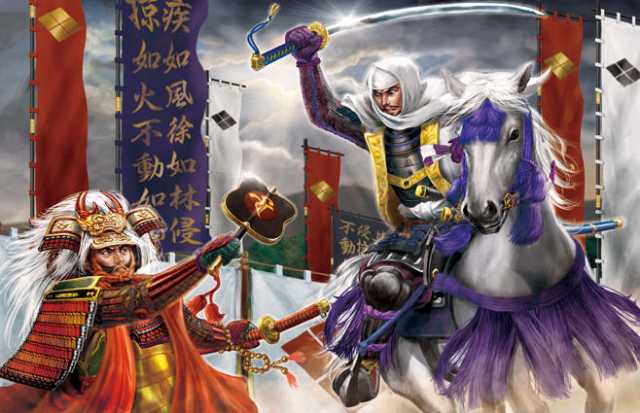
The Battles of Kawanakajima were a series of fierce conflicts during Japan's Sengoku period, waged between Takeda Shingen of Kai Province and Uesugi Kenshin of Echigo Province from 1553 to 1564. These battles centered around the strategic Kawanakajima plain, lying between the Sai and Chikuma rivers in northern Shinano Province, now within Nagano City. The rivalry began when Shingen took control of Shinano, forcing Ogasawara Nagatoki and Murakami Yoshikiyo to seek refuge with Kenshin, prompting repeated clashes.
There were five major battles: Fuse in 1553, Saigawa in 1555, Uenohara in 1557, Hachimanbara in 1561, and Shiozaki in 1564. The most notable of these was the Battle of Hachimanbara on October 18, 1561, which unfolded in the heart of the Kawanakajima plain and saw brutal casualties on both sides. Despite the intensity of these conflicts, neither Shingen nor Kenshin managed to secure definitive control of Kawanakajima.
These battles became iconic in Japanese military history, symbolizing valor, chivalry, and the tactical mastery of the Sengoku period. They are celebrated in Japanese literature, art, and popular culture for their dramatic and relentless nature.
Historical Background
Shingen initiated his campaign in Shinano in 1541, advancing in 1550 to capture several castles from Ogasawara Nagatoki, who fled to Murakami Yoshikiyo. Following intense skirmishes, Shingen forced Murakami out of his strongholds, taking Katsurao Castle in 1553, which led to Kenshin’s intervention and the subsequent battles.
The Major Battles
- First Battle of Kawanakajima (1553): Known as the Battle of Fuse, Shingen marched through Kawanakajima, reaching as far as the Chikumagawa River’s eastern bank, where he encountered Kenshin. Although initially repelled, Shingen pressed forward, defeating scattered Murakami forces, while Kenshin retreated before winter.
- Second Battle of Kawanakajima (1555): Also called the Battle of Saigawa, Shingen set camp south of the Sai River, while Kenshin held the east. The Kurita clan, allied with Shingen, supported him from Asahiyama fortress. Despite Kenshin’s repeated attempts to take this fortress, the armies eventually disengaged without a decisive battle.
- Third Battle of Kawanakajima (1557): Known as the Battle of Uenohara, Shingen captured the Katsurayama fortress near Zenko-ji temple. Kenshin advanced to engage Shingen but later withdrew without a major confrontation.
- Fourth Battle of Kawanakajima (1561): The largest and most famous battle, it saw Kenshin unexpectedly descending on Shingen's forces, catching them off-guard. Kenshin’s army attacked in waves, dealing heavy casualties. Kenshin himself attacked Shingen, who famously defended himself with his war fan until aid arrived. Though Kenshin’s forces withdrew, the battle inflicted a staggering toll on both sides.
- Fifth Battle of Kawanakajima (1564): Also called the Battle of Shiozaki, this final clash involved smaller skirmishes, with both sides withdrawing after 60 days.
Despite severe losses, neither side achieved lasting control over Kawanakajima. The sustained intensity of these battles immortalized them in Japanese history, becoming revered tales of strategy and valor that encapsulate the spirit of the Sengoku era.
See also
-
The Siege of Hara Castle

The Shimabara Rebellion of 1637–1638, which culminated in the siege of Hara Castle, was the last major uprising of the Edo period and had serious political consequences.
-
Battle of Tennoji

The confrontation between Tokugawa Ieyasu and Toyotomi Hideyori during the “Osaka Winter Campaign” ended with the signing of a peace treaty. On January 22, 1615, the day after the treaty was signed, Ieyasu pretended to disband his army. In reality, this meant that the Shimazu forces withdrew to the nearest port. On the same day, almost the entire Tokugawa army began filling in the outer moat.
-
Siege of Shuri Castle

The Ryukyu Kingdom was established in 1429 on Okinawa, the largest island of the Ryukyu (Nansei) archipelago, as a result of the military unification of three rival kingdoms. In the following years, the state's control spread to all the islands of the archipelago.
-
The Siege of Fushimi Castle

Fushimi can perhaps be considered one of the most “unfortunate” castles of the Sengoku Jidai period. The original castle was built by Toyotomi Hideyoshi in the southeast of Kyoto in 1594 as his residence in the imperial city.
-
The Siege of Otsu Castle

The siege of Otsu Castle was part of the Sekigahara campaign, during which the so-called Eastern Coalition, led by Tokugawa Ieyasu, fought against the Western Coalition, led by Ishida Mitsunari. Otsu Castle was built in 1586 by order of Toyotomi Hideyoshi near the capital Kyoto, on the site of the dismantled Sakamoto Castle. It belonged to the type of “water castles” — mizujō — as one side of it faced Japan's largest lake, Lake Biwa, and it was surrounded by a system of moats filled with lake water, which made the fortress resemble an island.
-
The Siege of Shiroishi Castle

The siege of Shiroishi Castle was part of the Sekigahara campaign and took place several months before the decisive battle of Sekigahara. The daimyo of Aizu Province, Uesugi Kagekatsu, posed a serious threat to Tokugawa Ieyasu's plans to defeat the Western Coalition, and Ieyasu decided to curb his actions with the help of his northern vassals. To this end, he ordered Date Masamune to invade the province of Aizu and capture Shiroishi Castle.
-
The Second Siege of Jinju Castle

During the two Korean campaigns of the 16th century, the Japanese repeatedly had to capture enemy fortresses and defend occupied or constructed fortifications from the combined Korean and Chinese forces. Among all the operations of that time, the second siege of Jinju Castle is considered the most interesting from the point of view of siege warfare.
-
The Siege of Takamatsu Castle

The siege of Takamatsu Castle in Bitchu Province is considered the first mizuzeme, or “water siege,” in Japanese history. Until then, such an original tactic had never been used.

